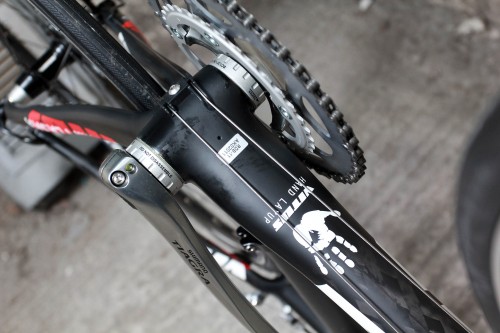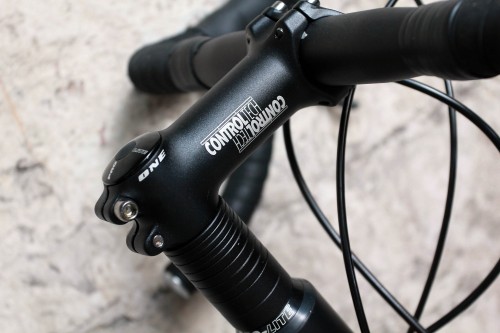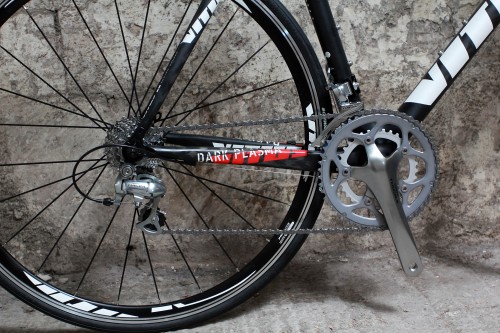- News
- Reviews
- Bikes
- Accessories
- Accessories - misc
- Computer mounts
- Bags
- Bar ends
- Bike bags & cases
- Bottle cages
- Bottles
- Cameras
- Car racks
- Child seats
- Computers
- Glasses
- GPS units
- Helmets
- Lights - front
- Lights - rear
- Lights - sets
- Locks
- Mirrors
- Mudguards
- Racks
- Pumps & CO2 inflators
- Puncture kits
- Reflectives
- Smart watches
- Stands and racks
- Trailers
- Clothing
- Components
- Bar tape & grips
- Bottom brackets
- Brake & gear cables
- Brake & STI levers
- Brake pads & spares
- Brakes
- Cassettes & freewheels
- Chains
- Chainsets & chainrings
- Derailleurs - front
- Derailleurs - rear
- Forks
- Gear levers & shifters
- Groupsets
- Handlebars & extensions
- Headsets
- Hubs
- Inner tubes
- Pedals
- Quick releases & skewers
- Saddles
- Seatposts
- Stems
- Wheels
- Tyres
- Health, fitness and nutrition
- Tools and workshop
- Miscellaneous
- Tubeless valves
- Buyers Guides
- Features
- Forum
- Recommends
- Podcast
news
Just in: Vitus Dark Plasma
It's not often that we get a bike in the road.cc offices that's named after a theory that postulates the existence of invisible lifeforms in the dark matter that makes up a major part of the universe. In fact it's only happened once, would you believe. And that bike is the Vitus Dark Plasma.
The Vitus name has a long, and some might say chequered, history in the bike trade. They're best remembered, fondly by some and less so by others, for their bonded 979 Aluminium frames in the late 1970s and early 1980s; the small diameter tubes were revolutionary at the time and offered plenty of comfort but at the expense of a certain amount of rigidity. Vitus were early adopters of Carbon too, making bonded frames based on their Aluminium ones in the early 1980s. Things went dark (sorry) for quite a while, but now Vitus is back, and in the UK they're exclusively available via Chain Reaction Cycles.

So can we expect an esoteric method of construction this time around? Well, no. The Dark Plasma is certainly a nice-looking frame though, constructed from high modulus Carbon with a 12K weave finish. That's mated to a full Carbon fork which on the Vitus website ends with a couple of spacers and a nice Control Tech stem, but on our test model you get eleven – count 'em – spacers for some serious fine tuning ability.You might be tempted to get your hacksaw out though if you want to get aero.

The Dark Plasma retails for £1149.99, so to get the full Carbon frame and fork at that money the kit is reliable rather than mouthwatering, but overall the bike looks pretty good value and you'd expect that the frame will be well worthy of upgrading. As specced you get a full Shimano Tiagra groupset, Vitus-branded wheels (made by Pro-Lite, so they should be well built) and Control Tech stem, bars and seatpost with Vitus' own saddle. That's a package that weighs in at 8.8kg (19.4lb) which isn't too shabby.

Vitus are pitching the bike as fit for everything from Audax to racing via club runs and sportives, so it'll be interesting to see which of those types of riding it suits best. Certainly it's shorter and consequently a bit more upright than Vitus' higher-end bikes, which suggests it'll be happier at the Sportive start line than the local crit, but we'll give it a thrash and let you know. Stay tuned.
Dave is a founding father of road.cc, having previously worked on Cycling Plus and What Mountain Bike magazines back in the day. He also writes about e-bikes for our sister publication ebiketips. He's won three mountain bike bog snorkelling World Championships, and races at the back of the third cats.
Latest Comments
- Rendel Harris 13 min ago
They've been removed now (see picture August '24), as per my comment below I think they were there to guard against cyclists riding through a blind...
- mdavidford 25 min 51 sec ago
It does have a lamp on it though...
- mdavidford 35 min 52 sec ago
If you're going to be ripped off, you should at least know how much you're being ripped off to the tune of....
- SecretSam 2 hours 21 min ago
I've just bought a second hand Mason but that 105 mechanical Strael looks a seriously good deal. Deeply pretty bike and I love the company ethos.
- andystow 5 hours 43 min ago
Ok, just noticing this on my own bike. The rear wheel I bought from wheelbuilder.com. The front I rebuilt on my existing SON hub with a rim ordered...
- jamesha100 10 hours 57 min ago
This is so sad but also so sadly familiar. I am not sure whether more punitive sentences - e.g. life driving bans - would make any difference but...
- chrisonabike 11 hours 17 min ago
Probably. But ... applied / enforced by whom? (See Private Eye's "Rotten Boroughs" page for evidence of how well that might work).
- Miller 11 hours 42 min ago
Because the reframing work in post is a right pain in the neck, the reframed quality doesn't match normal action cams, because the cameras are...

































Add new comment
7 comments
I rather conflated two separate issues in my original post, sorry. Firstly, fitting the stem so that it sits a few millimeters beyond the end of the steerer tube is a bad idea, because the clamping is uneven, and you can damage the vulnerable exposed ends of the crabon layers. As Leonard "at least one spacer above the stem" Zinn says, it is safer to choose your stem angle and steerer length such that the latter sticks out a couple of millimeters above the former, then put a 5mm spacer on top, giving you the few millimeters needed for proper headset adjustment. (Incidentally, the ultimate authority on bicycle maintenance on the web, Sheldon "Mr. Sobriquet" Brown didn't seem to have much of an opinion on the subject, but then I think he probably preferred quill stems.)
The second issue is that having as many spacers as shown in the photo above puts more lateral strain on the steerer. This is more of an issue with steerers than seatposts because (a) seatpost walls are often thicker (b) some of the seatpost is exposed so cracks can sometimes be seen before failure (c) sudden lack of support for the posterior is uncomfortable but nowhere near as dangerous as sudden loss of all steering, and (d) the weight on a seat post is mostly directed down its length, especially with the decreasing amount of offset many manufacturers are offering (I wonder why) whereas the stem acts as a lever on a steerer, applying a not-inconsequential torque every time you ride over a bump in the road.
While I choose not to purchase "all carbon" forks, I wouldn't go as far as saying they are unsafe for all riders in all circumstances. My comments was more concerned with the lazy use of the material of the fork steerer in reviews as a way to instantly classify bikes as either good value or ridiculously antiquated rip-offs that their manufacturers should be ashamed to let out the door. Not necessarily on this web site, although I notice there is no mention of the materials used in the construction of any other parts (but it is a "Just In" piece not a full review.)
Even though I am close to obtaining a Masters in engineering with some specialism in composite materials I dont feel qualified to post on this topic with any authority. Or perhaps it is that I have a better understanding of what would constitute qualified.
A carbon fibre reinforced plastic is substantially stiffer than aluminium when load is applied in line with the fibre direction. However the material is heavily anisotropic and heavily dependent on the volume ratio of fibre to matrix.
Basically I feel that it is an uninformed opinion that concludes that carbon head tube is bad thing with out knowledge of the exact material specification and fibre lay up, combined with a good understanding of the loading conditions its subjected to. Thats why we rely on a review to determine if there is "some thing funny" going on up front whilst its been ridden for a few hundred miles.
I would also postulate that on a road bike with a good position set up, perhaps except for under frontal braking, the load on the headtube is substantially smaller than load a 70kilo rider sitting on the saddle puts on seatpost (carbon or otherwise), espcially bearing in mind your seat could be seperated by 300mm from the clamp.
I do agree with Daves reasoning for aluminium stems.
However as I said, take my words with a pinch of salt.
With a *carbon* steerer many manufacturers recommend no more than 35mm of spacers. A longer length of unsupported carbon steerer is presumably more prone to failure due to increased leverage on the unsupported steerer between the stem clamp and the top headset bearings. Steel steerer tubes should be much more tolerant of 50mm of spacers - though the bike aesthetic police might not be
glad you got that off your chest, HC
I feel the same way about Carbon stems for the same reason. The amount of engineering and material you need to put into a Carbon stem to get the same level of stiffness as a simple Aluminium tube is ridiculous. They're almost never better, always more expensive and nearly always heavier. pft.
Hopefully that is just to cater for different size reviewers, and they don't actually sell them in that configuration. It is my understanding that clamping a stem right on the end of a plastic steerer, especially with so many spacers between it and the pivot point of the upper headset, is asking for trouble. Yet another reason why the totemic quality assigned these days to "all carbon" forks is misguided. I have read some reviews that basically praise a bike but conclude that the single fact that its fork steerer is constructed out of metal makes it a terrible value proposition. Alloy steerers can be just as light, are generally stronger (although nothing is perfect as George Hincapie found out at the 2006 P-R) and never splinter if you cut them down. You can use a star nut instead of struggling with a fiddly and weighty bung. Even if there is any weight or stiffness advantage, there are other areas of the bike where spending your budget to improve either quality will bring more significant gains.
What kind of trouble exactly? Extra leverage exerting too much stress on the top headset bearings? Or more stress on the steerer tube, making it more likely that a carbon steerer will break up?
I have 50mm of spacers on my Reynolds 631 winter bike: if the headset is in danger, I'd better change the arrangement. If it's just the steerer that suffers more, the steel steerer will presumably be fine.
Thanks in advance for any comments
"theory that postulates the existence of invisible lifeforms in the dark matter that makes up a major part of the universe"
you want to ask "MrChrispy" about that one I think.